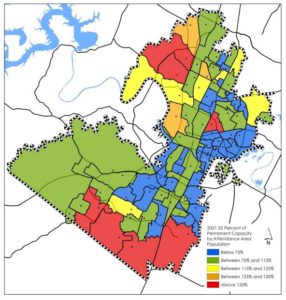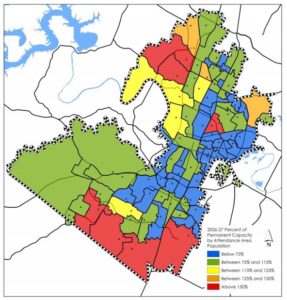AISD enrollment expected to decline at slower rate
Monday, January 9, 2017 by
Courtney Griffin In the first meeting of 2017, Austin Independent School District staff presented mixed news to the board of trustees in its annual demographic report. This report is used to predict 10-year student enrollment trends within the district based on housing and mobility data.
At Monday’s meeting, Beth Wilson, the district’s assistant director for planning services, began with the good news: The alarming rate of student enrollment decline that began in 2011 is expected to stabilize.
Wilson said that in 2026, AISD is expected to serve about 79,700 students, only an estimated 4,200 reduction from its current enrollment count. Last year, AISD expected to lose about 6,100 students by 2025.
“The rate is at a smaller rate than last year’s report,” she said. “(It’s) at less than half a percent annually.”
The projection stands in stark contrast to nearly half a decade of steep enrollment declines that district staff stated was caused by a combination of declining birth rates, Austin’s rising cost of living and nearby charter school competition.
In the 2012-2013 school year, AISD served more than 86,000 students and was expected to serve about 81,000 this year. With state education contributions at the tune of $7,390 per student, AISD’s enrollment decline made for a hefty revenue reduction.
AISD’s student population currently hovers at an estimated 83,000. Trustees credit some of the enrollment success to the implementation of an out-of-district student transfer policy, prekindergarten programs and a district-wide marketing initiative.
However, Wilson added, while AISD’s student population is declining less, it is still shifting unevenly throughout the district. This uneven growth and decline in enrollment causes facility problems as some schools end up largely over capacity, while other schools have classroom space to spare.
“We do see areas of our district that continue to see growth and added stress to some of our schools, particularly this year in the northwest region of the district,” Wilson said.
Wilson said that in the next five years, AISD elementary schools will bear the brunt of the unevenly distributed student population. The northwestern (Doss and Hill elementary schools) and the south central (Baranoff, Kiker and Menchaca elementary schools) parts of AISD are projected to be the hardest hit; some reaching more than 180 percent of the school’s intended capacity.

Percent of projected permanent capacity by attendance area population, 2021-22
However, many elementary schools in the eastern portion of the district – Zavala, Ortega, Norman, among others – could be anywhere from about 30 percent to 60 percent full.
District 2 Trustee Jayme Mathias noted that student populations from the Dove Springs area, formerly a residential suburb with many children enrolled in AISD, was expected to drop off dramatically.
“Dove Springs used to be very reliably affordable, and it is no longer. As rents increase in Central Austin … it’s relatively closer to downtown now,” Wilson responded.
District 5 Trustee Amber Elenz asked if staff was forecasting student enrollment projections for situations similar to the Grove at Shoal Creek planned unit development, a formerly unzoned state property that will become a major mixed-use development.
The development added a significant population increase to projections in nearby areas. Elenz said a similar situation could occur in her district, as there are 10 unzoned state properties within District 5. Development of said properties could result in the need for a new elementary school, she explained.
“We’re talking 400 to 500 acres of undeveloped property in my area,” she said. “I feel like there needs to be some alternative scenarios being run (that factors in unexpected development). … We do know with this land, something is going to happen.”
AISD staff said that potential scenarios could be run in the future with demographers. Staff added that many more less-than-finalized residential developments in the works within AISD boundaries were not included within the district’s student projections because of the developments’ unknown timelines.

Percent of projected permanent capacity by attendance area population, 2026-27
AISD demographers said 95 residential developments, totaling about 13,400 units, will be built in the next 10 years within AISD boundaries. However, according to the report, only one-fourth are detached single-family units. The remaining are apartments or multifamily units, which can be duplexes or town homes.
This report will be used to inform AISD’s Facilities and Bond Planning Advisory Committee, whose report regarding future bonds or facility closures is expected in March 2017.
Photo by Max Klingensmith made available through a Creative Commons license. Maps provided by AISD.
The Austin Monitor’s work is made possible by donations from the community. Though our reporting covers donors from time to time, we are careful to keep business and editorial efforts separate while maintaining transparency. A complete list of donors is available here, and our code of ethics is explained here.
You're a community leader
And we’re honored you look to us for serious, in-depth news. You know a strong community needs local and dedicated watchdog reporting. We’re here for you and that won’t change. Now will you take the powerful next step and support our nonprofit news organization?





